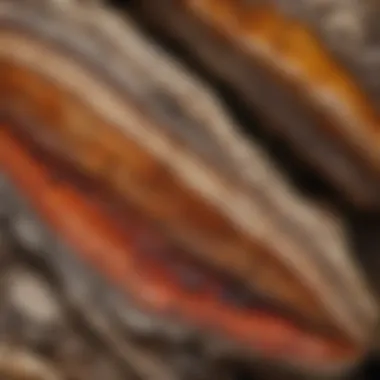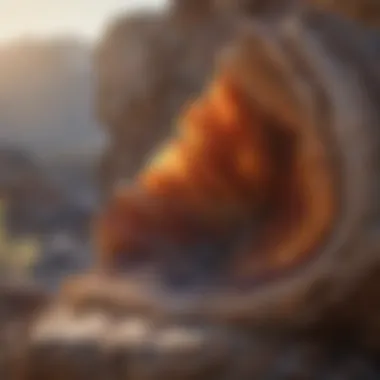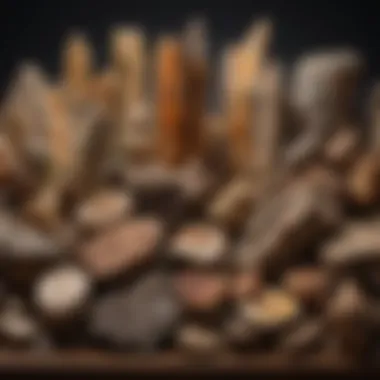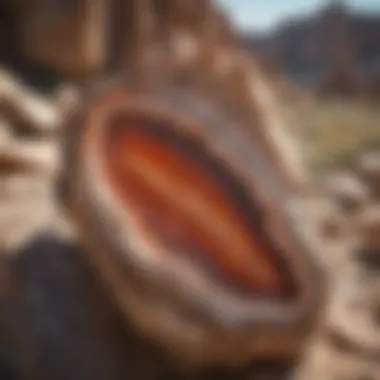Unveiling the Captivating World of Petrified Wood: Insights into Its Value and Significance


Rock and Fossil Identification
In the enthralling world of petrified wood, understanding rock and fossil identification is key to appreciating the intricate beauty of these unique geological specimens. Petrified wood is a type of fossilized remains of ancient trees, where the organic materials have been replaced with minerals over millions of years. When identifying petrified wood, one should look for specific characteristics such as the wood's texture, color variations, and any preserved tree rings. Advanced tools like handheld magnifiers, UV lights, and hardness testing kits can aid in distinguishing between different types of rocks and fossils.
Geological Insights
Diving deeper into the geological insights of petrified wood unveils a fascinating journey through time and natural processes. Petrified wood originates from trees that have fallen and been rapidly buried by sediment, preventing decay and allowing for the organic material to be replaced by minerals like silica, quartz, and quartzite. These geological formations give us a glimpse into ancient ecosystems and climates, shedding light on Earth's history and evolution. Notable discoveries of petrified wood have been made in various regions, offering valuable insights into prehistoric flora and ecosystems.
Collecting Tips and Techniques
For avid collectors interested in acquiring petrified wood specimens, knowing the best practices and techniques is essential. When embarking on a collecting expedition, it is important to research and locate prime sites known for their abundance of petrified wood. Safety is paramount when extracting specimens, requiring tools like rock hammers, chisels, and eye protection to carefully unearth and collect the fossils. By following ethical guidelines and respecting natural environments, collectors can responsibly gather petrified wood to add to their collections.
Preservation and Display
Preserving petrified wood specimens ensures their longevity and visual appeal for future generations to appreciate. Techniques such as applying consolidants to stabilize fragile specimens and keeping them in a controlled environment free from excessive moisture and sunlight can prevent deterioration. Proper storage methods, such as using acid-free paper and storage boxes, help maintain the integrity of petrified wood. When considering creative display ideas, showcasing petrified wood in naturalistic settings or using LED lighting to accentuate the colors and textures can enhance the beauty of these remarkable geological treasures.
Introduction
The topic of petrified wood is a fascinating one that unveils a world of geological wonders and mysteries. This article delves deep into the captivating realm of petrified wood, providing a comprehensive insight into its value and significance as unique geological specimens. From exploring its formation process to discussing its worth in the realm of collectors and geological enthusiasts, this article aims to offer a detailed guide into understanding the intriguing world of petrified wood.
Defining Petrified Wood
The Process of Fossilization
The process of fossilization is a crucial aspect of understanding petrified wood and plays a significant role in its formation. Petrified wood is created through a meticulous process where organic matter is slowly replaced by minerals, ultimately transforming wood into stone. This process preserves the intricate details of the wood structure, resulting in beautifully preserved specimens that captivate collectors and enthusiasts alike. The unique feature of fossilization lies in its ability to immortalize ancient trees, allowing us to glimpse into Earth's history with each petrified piece. While the process of fossilization may be time-consuming, the end result is invaluable in providing us with tangible connections to the past.
Distinctive Features of Petrified Wood


The distinctive features of petrified wood set it apart from other geological specimens and make it a sought-after choice for collectors and enthusiasts. Petrified wood exhibits mesmerizing patterns and colors that result from the minerals that replace the organic material over time. These unique characteristics, such as intricate grain patterns and vibrant hues, make petrified wood a desirable addition to any collection. The durability of petrified wood also adds to its appeal, as it can withstand the test of time and retain its beauty for generations to come. While petrified wood may pose challenges in terms of weight and handling due to its stone-like nature, its distinctive features outweigh any disadvantages, making it a prized possession for many.
Historical Significance
Ancient Folklore and Beliefs Surrounding Petrified Wood
Ancient folklore and beliefs surrounding petrified wood provide a cultural and mythical context to this unique geological specimen. Throughout history, petrified wood has been associated with various legends and superstitions, with different cultures attributing mystical properties to these stone fossils. From beliefs in petrified wood warding off evil spirits to ancient tales of petrified wood embodying the spirits of trees, the historical significance of these beliefs adds layers of intrigue to the allure of petrified wood. By delving into the ancient folklore and beliefs surrounding petrified wood, we gain a deeper appreciation for its cultural significance and the timeless fascination it continues to evoke.
Formation Process
In this crucial section of the article unraveling the intriguing world of petrified wood, the focus shifts towards understanding the pivotal process of how these unique geological specimens come into existence. The formation process is a cornerstone of the entire narrative, shedding light on the intricate transformation from organic matter to mineralized relics. By delving into this topic, readers can grasp the essence of petrified wood's origins and appreciate the geological forces at play. Understanding the formation process offers a profound insight into the mesmerizing world of petrified wood.
Organic Matter Replacement
How organic material is replaced by minerals
Discussing the phenomenon of how organic material is gradually substituted by minerals is fundamental to comprehending the essence of petrified wood. This specific aspect highlights the gradual but fascinating transition that organic matter undergoes, ultimately resulting in the preservation of intricate details within the wood. The intricate interplay between organic material and mineralization showcases nature's ability to create enduring geological wonders. By replacing organic elements with minerals, the petrification process immortalizes the essence of ancient wood in a mineralized form.
Conditions for Preservation
Factors conducive to the formation of petrified wood
Exploring the factors that facilitate the preservation of petrified wood is key to understanding its lasting beauty and significance. The specific aspect of factors conducive to petrification underscores the environmental conditions necessary for the successful fossilization of wood. Highlighting key characteristics such as mineral-rich sedimentary environments and the absence of oxygen provides insights into the optimal settings for petrification. By unraveling the unique features that support wood preservation, enthusiasts can appreciate the delicate balance required for the formation of petrified wood and its ultimate significance in the world of geological wonders.
Value Assessment
Determining Factors
Color, Clarity, and Structure


Delving into the determining factors of petrified wood's value, color, clarity, and structure emerge as critical elements that significantly influence its desirability and market worth. The vibrant hues that range from earthy browns to vivid reds and yellows in petrified wood not only showcase its natural beauty but also indicate the mineral composition within the specimen. The clarity of the growth rings and mineral patterns intricately preserved in petrified wood not only provide insights into its formation process but also enhance its aesthetic appeal. Furthermore, the intricate structural formations, including intricate wood grain patterns and unique textures, add a layer of sophistication and uniqueness to each piece, making it a distinctive choice for collectors and enthusiasts.
Market Trends
Delve into the dynamic realm of market trends surrounding petrified wood, particularly focusing on the demand and pricing fluctuations observed within the collectors' market. Exploring the factors that drive demand for these petrified wood specimens unveils a fascinating narrative of rarity, unique aesthetics, and historical significance that contribute to their appeal among collectors. Additionally, understanding the pricing dynamics within the market provides valuable insights into the investment potential of petrified wood as a collectible item. By examining the demand-supply dynamics and the evolving trends in collector preferences, one can navigate the market with insight and make informed decisions when acquiring or evaluating petrified wood pieces.
Collectors' Perspective
In the realm of petrified wood, the Collectors' Perspective holds a crucial position, shaping the appreciation and acquisition of these unique geological specimens. For rock and fossil collectors, understanding the importance of this perspective provides insights into the historical, scientific, and aesthetic value of petrified wood. Collectors play a pivotal role in preserving and showcasing these natural wonders, contributing to the broader exploration and appreciation of Earth's ancient treasures. By focusing on the essence of Collectors' Perspective, individuals can delve deep into the captivating world of petrified wood, unraveling its mysteries and inherent beauty.
Appreciation and Aesthetics
Unique beauty and appeal of petrified wood
The Unique beauty and appeal of petrified wood lie in its extraordinary transformation from organic matter into stone, capturing moments in Earth's history with intricate patterns and vivid colors. Petrified wood showcases nature's artistry, with each specimen revealing a story of evolution and preservation over millions of years. The key characteristic of this unique beauty lies in its mesmerizing blend of earthly tones and crystal-like structures, creating a mesmerizing visual display. Petrified wood's appeal as a collector's item stems from its rare combination of natural artistry, historical significance, and geological intrigue.
Acquisition and Display
Tips for acquiring and showcasing petrified wood specimens
Tips for acquiring and showcasing petrified wood specimens offer valuable guidance for collectors seeking to enrich their collections and share these marvels with others. Understanding the provenance and quality of petrified wood is essential for making informed acquisition decisions. Display considerations play a vital role in enhancing the aesthetic appeal of petrified wood, with factors such as lighting, positioning, and context influencing the overall impact. By utilizing these tips effectively, collectors can elevate the viewing experience of petrified wood specimens, creating captivating showcases that captivate audiences and highlight the unique beauty of these geological treasures.
Preservation Techniques
In this section of the comprehensive guide on Unveiling the Intriguing World of Petrified Wood, the focus shifts to the critical aspect of Preservation Techniques. Petrified wood, with its unique characteristics, requires specific methods to ensure its longevity and visual appeal are maintained for generations to come. Preservation Techniques play a pivotal role in safeguarding these invaluable geological specimens.
Preserving petrified wood involves employing techniques that protect the delicate structure and enhance the aesthetic qualities of these fossilized treasures. By understanding and implementing proper preservation strategies, collectors and enthusiasts can prolong the lifespan of petrified wood while showcasing its natural beauty.
Maintenance Practices


When discussing maintenance practices for petrified wood, the primary goal is to uphold its longevity and luster, preserving its allure over time. Ensuring that these geological specimens retain their original splendor requires meticulous care and attention.
Ensuring Longevity and Luster of Petrified Wood
Ensuring the longevity and luster of petrified wood is essential in maintaining its appeal and value. This aspect involves regular cleaning, protection from environmental factors, and appropriate display methods to prevent deterioration.
One key characteristic of maintaining the longevity and luster of petrified wood is the use of gentle cleaning techniques. Avoiding harsh chemicals or abrasive cleaning products is crucial to preserving the delicate surface of petrified wood and preventing damage.
Implementing methods to shield petrified wood from direct sunlight or excessive humidity also contributes to its longevity. By controlling the environmental conditions in which petrified wood is displayed or stored, collectors can prevent discoloration or deterioration over time.
The unique feature of prioritizing the longevity and luster of petrified wood lies in the ability to retain the specimen's original sheen and coloration. This proactive approach not only enhances the visual appeal of petrified wood but also maintains its structural integrity, making it a practical and popular choice for collectors and enthusiasts alike.
Display Considerations
Another essential aspect highlighted in this article is Display Considerations, concentrating on the optimal settings for exhibiting petrified wood specimens to accentuate their beauty and geological significance. Choosing the right display settings is integral to showcasing these timeless treasures effectively.
Optimal Settings for Exhibiting Petrified Wood
Optimal settings for exhibiting petrified wood play a vital role in capturing the attention of onlookers and preserving the integrity of these geological marvels. Factors such as lighting, temperature, and positioning of the specimens all contribute to creating a visually stunning display.
The key characteristic of optimal settings for exhibiting petrified wood is the emphasis on natural lighting. Placing petrified wood in well-lit areas allows its colors and textures to be illuminated, revealing intricate details that might otherwise go unnoticed.
Choosing the right display furniture or stands that complement the aesthetic qualities of petrified wood is a beneficial choice for enhancing its overall appeal. Properly positioning the specimens to showcase unique patterns or textures can captivate viewers and emphasize the beauty inherent in these fossilized remnants.
The unique feature of optimal settings for exhibiting petrified wood lies in creating an immersive experience for observers, transporting them into the intriguing world of geological history. By carefully considering display considerations, collectors can effectively share the allure and significance of petrified wood with a wider audience, making it a valuable asset in any collection.
Conclusion
In concluding this comprehensive guide on the intriguing world of petrified wood, it becomes evident that the significance and value of these unique geological specimens span far beyond their outward appearance. Petrified wood stands as a testament to the intricate processes of nature, offering viewers a glimpse into the depths of time and transformation.In a world where fast-paced trends often dominate, petrified wood's timeless allure serves as a reminder of the enduring beauty and resilience of nature. Its ability to capture moments from ancient forests and crystallize them into mesmerizing patterns reflects a harmony between the past and present that is unparalleled in the geological realm. As collectors and enthusiasts continue to seek out these rare treasures, appreciating the subtle nuances and rich story encapsulated within each specimen becomes a journey of exploration and reverence.
Appreciating the Timeless Beauty
The enduring allure of petrified wood in the modern age
Delving into the enduring allure of petrified wood in the modern age unveils a captivating narrative that transcends time. The seamless blend of ancient wisdom preserved in these organic structures with the contemporary aesthetics of today's world creates a compelling contrast that appeals to the discerning eye. The petrified wood's unique ability to bridge the gap between eons gone by and the current era positions it as a symbol of continuity and transformation.The striking visual appeal of petrified wood, characterized by its vibrant hues and intricate patterns, complements a wide range of interior design styles, making it a versatile choice for collectors and enthusiasts alike. Its durability and resilience make it a sought-after choice for those seeking not just a decorative piece but a tangible connection to Earth's history. While each piece carries its distinct charm, the enduring allure of petrified wood lies in its capacity to spark awe and admiration, transcending mere decoration to become a statement of profound appreciation for nature's artistry.







